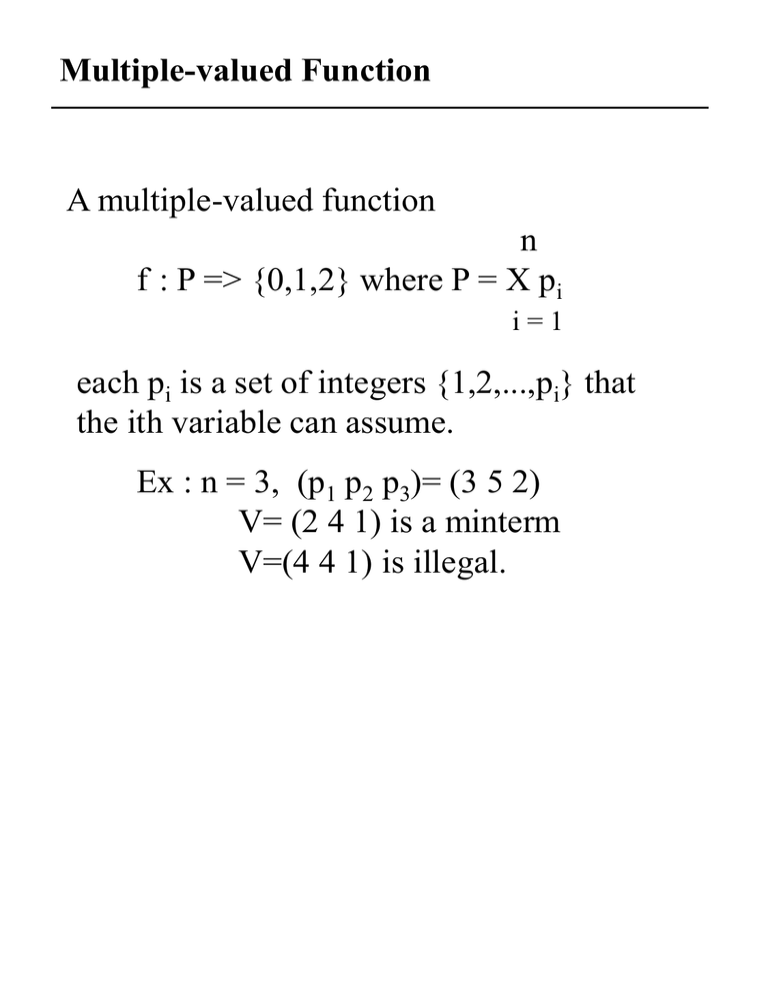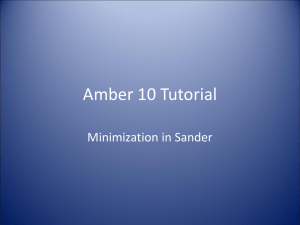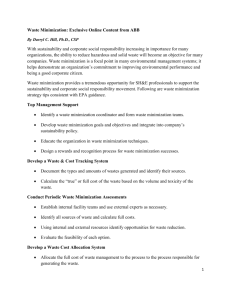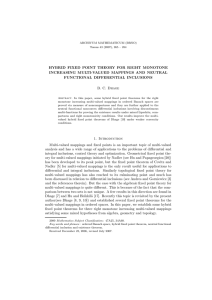Multi-valued Logic Minimization
advertisement

Multiple-valued Function
A multiple-valued function
n
f : P => {0,1,2} where P = X pi
i=1
each pi is a set of integers {1,2,...,pi} that
the ith variable can assume.
Ex : n = 3, (p1 p2 p3)= (3 5 2)
V= (2 4 1) is a minterm
V=(4 4 1) is illegal.
Multiple-valued Function
• To represent multiple valued variable using
two-valued variables : one hot encoding
For a variable which can take pi values, we
associate pi Boolean variables.
Ex:
(p1 p2 p3) = (3 5 2)
(
) (
Ex:
n = 3 (p1 p2 p3) = ( 3 5 2)
V= ( 2 4 1 ) will be represented
(0 1 0)(0 0 0 1 0)(1 0)
This should be thought of as a
“minterm”.
)(
)
Product Term
• A general product term
C = ( 1 1 0)(0 1 1 0 1)(1 0) means
(V1 = 1 or 2)and (V2 = 2 , 3, or 5) and
(V3 =1)
• The problem of multi-valued logic
minimization is to find an above form of
minimized number of product term.
Multi-valued Logic Minimization
Three questions to answer:
1. How to use a two-valued logic minimizer
to minimize multiple valued logic.
2. When to use a multiple-valued logic?
3. How to realize a multiple-valued logic?
Multiple-valued Logic Minimization
3. How to realize a multiple-valued logic?
– using decoder to generate multiple value
logic
Ex : using a two-bit decoder to generate
4-value logic
x1’x2’
x1
x2
two
x1’x2
bit
x1x2’
decoder x1x2
outputs
AND
OR
Multi-valued Logic Minimization
x0’x1’
x0’x1
x0x1’
x0x1
m0
m1
m2
m3
x0 x1 f
0 0 0 M0
0 1 0 M1
1 0 1 M2
1 1 0 M3
x0+x1
x0+x1’
x0’+x1
x0’+x1’
implement f
use min-terms f = x0x1’ = (m2)
use max-terms
f’ = (x0’x1’)+(x0’x1)+(x0x1)
f = (x0+x1) (x0+x1’) (x0’+x1’)
= M 0 M1 M 3
= (M0 , M1 , M3 )
Example
Ex : multiple output function
f = (p1 p2 p3) = (1110)(0011)(0111)
p1 p2 p3 {1,2,3,4}
one product term
2-bit
decoder
2-bit
decoder
AND
plane
2-bit
decoder
OR
plane
Example
0111----0001----1 0 0
0011----0011----1 0 0
0001----0111----1 0 0
1010----0101----0 0 1
0101----1010----0 0 1
1100----0010----0 1 0
0110----0100----0 1 0
1001----0001----0 1 0
0011----1000----0 1 0
x1
x2
x3
x4
f0
f1
f2
PLA for ADR2(input variable assignment
nonoptimized).
Multi-valued Logic Minimization
1. How to use a two-valued logic minimizer to
minimize multiple valued logic?
Ex:
(1 0 0)(1 0 1 0)(1 0)
+ (0 1 0)(1 0 1 0)(1 0)
=> (1 1 0)(1 0 1 0)(1 0)
A product term involves both “AND” and
“OR”. But in two-valued logic, a product
term involves “AND” only.
Multi-valued Logic Minimization
• How to change “OR” relations to “AND”
relations?
solution => Don’t care
Ex:
Consider the second 4-valued variable
V2 = (1 0 10)
means V2 = 1 or V2 = 3
use “AND” to represent the meaning
“ V2 not 2 and not 4”
Two valued logic:
(0 0 0 0) don’t care
(0 0 1 0)
(1 0 0 0)
(1 0 1 0) don’t care
=> V2 = (2 0 2 0 )
Multi-valued Logic Minimization
• The Don’t care set?
x1 x2 x3
care set = 1 0 0
0 1 0
0 0 1
don’t care: x1 x2 x3
1 1 2
1 2 1
2 1 1
0 0 0
No pair of two xi are both on and xi are
never all off.
Multi-valued Logic Minimization
• Use two-valued logic minimizer to
minimize a multi-valued logic:
step (1) create Pi Boolean variables
step (2) For each multi-valued variable,
we associate the Don’t care set
step(3) espresso
step(4) convert the result back to
multiple-valued function
Example
8-valued 4-valued
100000001000 | 10000000 - - 001000001000 | 10000000 - - .................................................
010000001000 | - - - - - - - -000
000010001000 | - - - - - - - -000
..................................................
001000000100 | 10000000 - - 000000100100 | 10000000 - - ..................................................
010000000100 | - - - - - - - -000
..................................................
001000000001 | - - - - - - - -101
000000100001 | - - - - - - - -101
Multi-valued Input Version of PLA
DK17(Don’t-cares not shown)
Example
20020000
00000000
00010000
10000000
10010000
0. 00. .0. . .1. | - -1 - - - - - -1
0000. .0. . . .1 | - -1 - - - - - 1. 0. 00000. .1. | - 1- - - - - - - . . 00. 000. 1.. | - - - 1- - - - - ..............................................
. 00. 0000. . .1| - - - -1- - - - 1
00. 000. 0. 1. .| 1- - - - - - -1 . . . . . 1. . . 1. .| - - - - - - - 1- ...............................................
. 1 . . . . . . . ..1| - - - - - 1- - - -
Multi-valued Input Minimization
of DK17
2212
0010
0011
0110
0111
1010
1011
1110
1111
Example
010011010010 | - - 1 - - - - - - 1 000011010001 | - - 1 - - - - - 1 - 101000000010 | - 1 - - - - - - - - 1
110010000100 | - - - 1 - - - - - - .....................................................
100100000001 | - - - - 1 - - - - 1 001000100100 | 1 - - - - - - - 1 - 1
000001000100 | - - - - - - - 1 - - ......................................................
000000101000 | - - - 1 - - - - - 1 000001001000 | - - - - - - 1 - - - 010000000001 | - - - - - 1 - - - - MINI Representation of Minimized
DK17
Multi-valued Logic Minimization
2. When to use a multiple-valued logic ?
– state assignment to find adjacency
relations
– allowing bit pairing to minimize logic
Example
x1 x2
+ x3 x4
f0 f1 f2
Two-Bit ADDER(ADR2)
x1 x2 x3 x4
f0 f1 f2
0
0
0
0
0
0
0
0
1
1
1
1
1
0
0
0
0
0
0
0
1
0
0
1
1
0
0
0
0
0
1
1
1
1
0
0
0
0
1
0
0
1
1
0
0
1
1
0
0
1
1
0
0
1
0
1
0
1
0
1
0
1
0
1
0
1 1 0 1
1 1 1 0
1 1 1 1
0
0
1
1
0
1
1
0
1
1
0
0
1
0
1
0
1
1
0
1
0
0
1
0
1
1
1 0 0
1 0 1
1 1 0
Example
x1
x2
x3
x4
f0
f1
f2
Example
pair
TABLE IV
X1=(x1 x2) Two-Bit ADDER(ADR2)
X2=(x3 x4)
1
2
3
4
x1 x 2 x3 x4
f0 f 1 f2
0
0
0
0
0
0
0
0
1
1
1
1
1
0
0
0
0
0
0
0
1
0
0
1
1
0
0
0
0
0
1
1
1
1
0
0
0
0
1
0
0
1
1
0
0
1
1
0
0
1
1
0
01
12
03
14
0
1
0
1
0
1
0
1
0
1 1 0 1
1 1 1 0
1 1 1 1
0
0
1
1
0
1
1
0
1
1
0
0
1
0
1
0
1
1
0
1
0
0
1
0
1
1
1 0 0
1 0 1
1 1 0
Example(cont.)
X1
X2
f0f1f2
1000----0100----0 0 1
1000----0010----0 1 0
1000----0001----0 1 1
0100----1000----0 0 1
0100----0100----0 1 0
0100----0010----0 1 1
0100----0001----1 0 0
0010----1000----0 1 0
0010----0100----0 1 1
0010----0100----1 0 0
0010----0001----1 0 1
0001----1000----0 1 1
0001----0100----1 0 0
0001----0010----1 0 1
0001----0001----1 1 0
Example(cont.)
0111----0001----1 0 0
0011----0011----1 0 0
0001----0111----1 0 0
1010----0101----0 0 1
0101----1010----0 0 1
1100----0010----0 1 0
0110----0100----0 1 0
1001----0001----0 1 0
0011----1000----0 1 0










